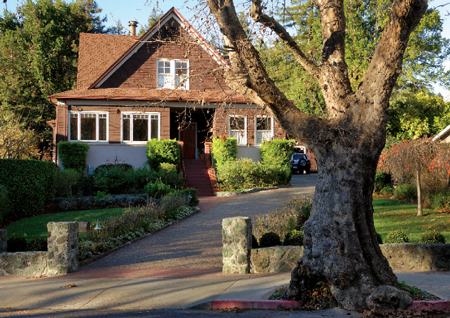“I live in the neighborhood known as Sycamore Park,” says Elaine Cramer, with a high degree of certainty in her voice. “I know I do.” Yet because of its defining physical characteristic, she concedes, her tight-knit Mill Valley community is also called “the flats.”
Many of Cramer’s neighbors say “Sycamore Park” is the sobriquet loosely (and, some insist, incorrectly) applied to the entire triangle of homes situated between East Blithedale, Miller Avenue and Camino Alto. “Actually, two distinct neighborhoods exist between Miller and East Blithedale,” says realtor Judy LeMarr of Frank Howard Allen in Mill Valley. “Sycamore Park, which is mostly smaller tract homes built on level land just after World War II, and Tamalpais Park, going back to the early 1900s, when individually built homes were constructed on curving streets and gently rolling terrain.” For most residents, the neighborhoods’ line of demarcation is along Locust and LaGoma avenues.
Whichever name they use for it, inhabitants unconditionally love this part of town. “We’ve lived in Sycamore Park for over 20 years,” says Elaine Cramer’s husband, Matt, “and I like the place more every day.” In fact, except for a few years in San Francisco, he’s lived in the vicinity all his life—”I grew up here”—and nine of his neighbors, all in their 40s and 50s, are Marin natives too. “My folks bought over on Oxford Avenue in ’52; they paid $11,500 for the place; Mom still lives there,” is how he sums it up.
Homes in Sycamore and Tamalpais Park now sell for 200 times that amount. Why? Let resident Kirk Citron, a retired advertising exec who’s currently writing a novel, spell it out. “Three words. Walk—to—everything.” He’s not exaggerating. From the down-home 2 AM Club and Joe’s Taco Lounge to the upscale Whole Foods; from Sycamore Park Preschool to Park Elementary to Mill Valley Middle School to Mount Tamalpais High; from the 225-seat Marin Theatre Company to the two-mile Mill Valley–Sausalito bike and running path—for these destinations and more, the almighty auto is not the required (nor preferred) mode of access. And it’s only a 15-minute stroll to the cafes, boutiques and entertainment venues of downtown Mill Valley or a 10-minute jaunt to the recently completed Mill Valley Community Center. Then there are the two public parks within the neighborhoods’ bounds: Sycamore Park, which had a volunteer-inspired renovation in 2006, and Freeman Park on Ryan Avenue.
But life here isn’t pure bliss. “This time, one word says it all,” says author Citron. “Traffic.” Outsiders often use neighborhood streets as shortcuts to get across Mill Valley. Hence Friends of Mill Valley—a slow-growth, some say no-growth organization—was formed, ostensibly to oppose any further development along Miller Avenue, but “most of the group’s leadership comes from Sycamore and Tamalpais Park,” Citron points out.
Yet a little added crosstown traffic hasn’t really put a crimp in real state prices. “Whenever a house comes on the market in either Tamalpais or Sycamore Park, it’s a usually feeding frenzy,” says Jane Richmond of Pacific Union in nearby Strawberry Village. A family with two children should expect to pay in “the $2 million range,” she says, for a four-bedroom home of around 2,000 square feet that’s on a level lot and not in need of considerable work. Tamalpais Park houses, being larger and often Craftsman or Victorian in style, tend to sell for more than the homes in postwar Sycamore Park.
The area’s lowest-priced homes either are two-bedroom one-bath or need considerable work, says Frank Howard Allen’s LeMarr. “Currently, four such properties are on the market. They’re priced from the high $700,000s to just over a million, depending on location.” From there, prices go up to $2,495,000 for what listings call “a classic Craftsman with four bedrooms and three baths that was totally rebuilt in 2001” and to $3,250,000 for the “Jewel of Tamalpais Park,” a brown-shingled four-bedroom with library and formal dining room on a half-acre level lot.
As with many in-demand Marin communities, one of the fundamental attractions is family-friendly neighbors. “Oh my gosh, talk about friendly,” Elaine Cramer says. “This Halloween we had over 450
trick-or-treaters.” LeMarr seconds that when pitching the area to potential buyers: “I often refer to them both as ‘trick-or-treat neighborhoods,’” she says.


